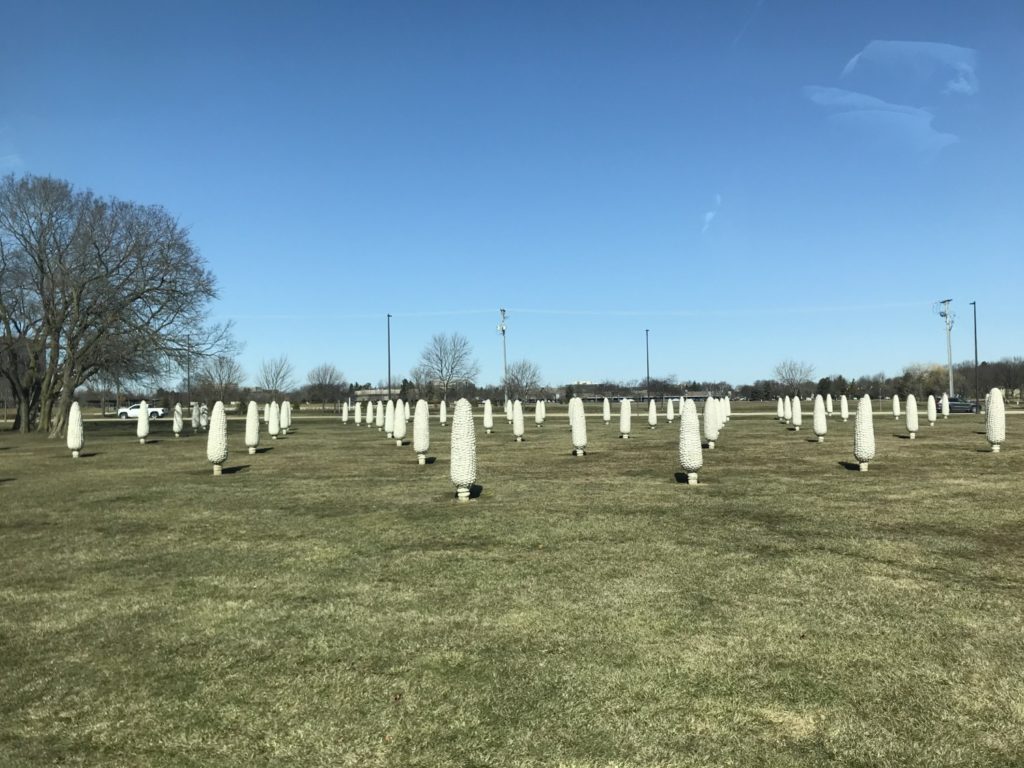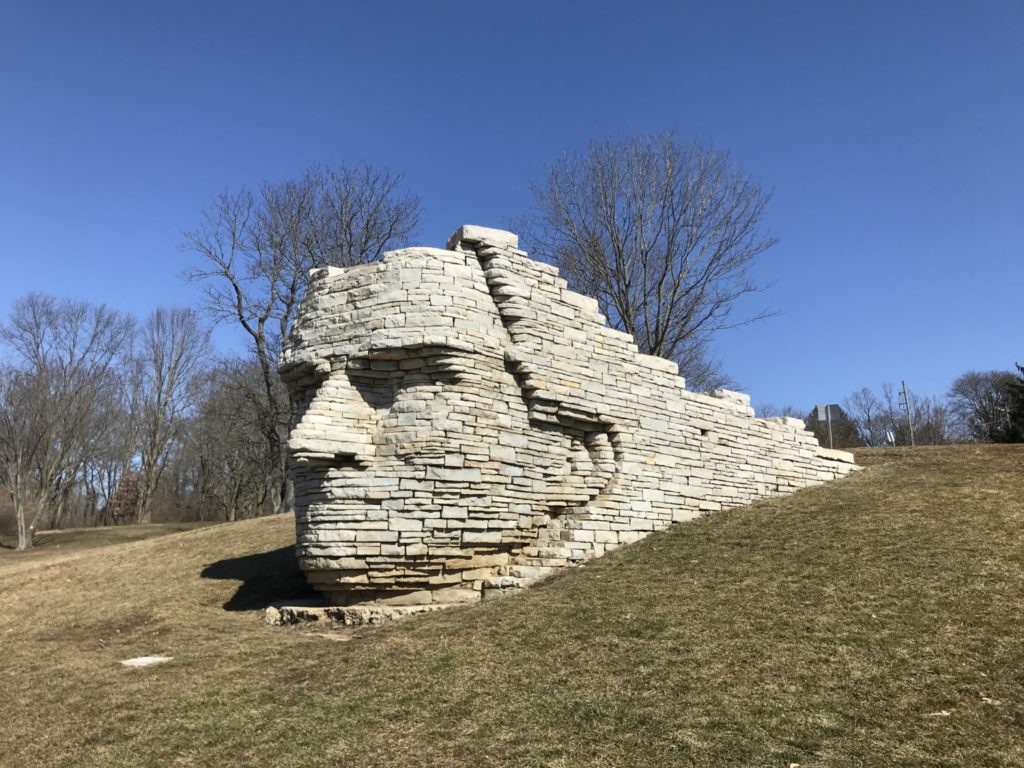During our scavenger hunt of Dublin, Ohio with my parents, we found five sculptures as well as two waterfalls and two historic parks. I never knew Dublin was such a hotbed of artistic activity, but the five sculptures we found are not the only ones in Dublin – just the most public. The Dublin Arts Council is actively working to get people involved in the arts in many different ways.
I will start with the five sculptures we found, before giving you more information about other ways to find art in Dublin. The first sculpture was also the most challenging. We wanted to find the Jack Nicklaus sculpture. Jack Nicklaus was an important person in the city of Dublin. He envisioned and built a championship golf club surrounded by a first-class residential community. This area became known as Muirfield Village. The Muirfield Village Golf Club is the home to the PGA Memorial Tournament. A Jack Nicklaus Museum is housed on the Ohio State Campus.
The city of Dublin and the Dublin Arts Council, commissioned the sculpture to recognize the contributions made to the Dublin community by Nicklaus. They hired sculptors Jeffrey Varilla and Anna Kohl-Varilla to make the sculpture. The sculpture, which was unveiled in 1999, shows Mr. Nicklaus as a senior master of golf, and also as a mentor, teacher and role model. Jack Nicklaus is teaching a child how to golf. The figures are larger-than-life size, cast in bronze and located in the wide median at Avery/Muirfield Drive at Brand Rd.
We thought the statue was located in the center of one of the Dublin round-abouts, so we drove round about several of them before Tom went in a different direction. We knew it had to be close to Muirfield Village. If we had found the Dublin Arts Council page before we set out, it would have been easier. The statue is located in the median of a boulevard. There wasn’t anyplace to park to get a good picture, so here is the picture from the car window.

Our second sculpture is the most famous one in Dublin, “The Field of Corn,” or “Cornhenge” in local parlance. Although the biggest art installation in Dublin, we didn’t find it very inspiring. There is a field with 109 six-foot ears of corn. The installation symbolizes the history of the community’s farming legacy and serves as a memorial to rural landscapes, which Dublin definitely no longer has.
Ohio artist Malcolm Cochran, a professor of sculpture at the Ohio State University, created “The Field of Corn” along a busy intersection. The land was once owned by Sam and Eulalia Frantz, leaders in the use of hybridized corn. Cochran used white architectural precast concrete for each of the ears of corn. He made three full-sized prototypes, each with a different kernel patter, from which the molds were made. Each ear of corn weighs 1,500 pounds. The installation was dedicated on October 30, 1994.
Although the park is along a busy intersection, there is a parking lot so you can stroll along the rows of corn and appreciate the unique sculpture. The day we were there was overcast and cold, but there were several people enjoying the field of corn.

Our third sculpture was my favorite out of all that we saw and the only one not commissioned by the Dublin Arts Council. The “Dancing Hares” is a giant piece at the Ballantrae Community Park Splash Pad. The Dancing Hares are on a hill located behind the splash pad. Inspired by the ways rabbits box in courtship in the spring, artist Sophie Ryder created the three 24′ tall hares out of scrap metal materials. Items such as pipes, hammers and screws are embedded with other everyday household objects in the sculptures. This gives viewers a scavenger hunt within the art scavenger hunt while they admire the hares.
A concrete path winds around the hill to the top with the Dancing Hares. I climbed to the top and admired both the statues and the view. Although it was a little windy and cold, it was interesting to see the different objects embedded in the rabbits. And the rabbits were just plain fun! An unexpected touch of whimsy in the middle of Dublin.

The fourth sculpture we visited was “Leatherlips,” a tribute to Wyandot Chief Leatherlips. This sculpture was the Dublin Arts Council’s first Art in Public Places project. The sculpture was created by Boston artist Ralph Helmick. The sculpture, a 12-foot high portrait of Chief Leatherlips, was installed in Scioto Park in 1990. The head is made of native limestone stacked and mortared. The sculpture is open on the top and has stacked stones extending back along its sides, creating a small enclosure that enables visitors a view of the river, the sunset and the amphitheater.
Local history relates that Chief Leatherlips was executed by fellow tribesman at a location very near Scioto Park. Early histories by the white settlers of the time described the old Chief as intelligent, dignified and peaceful. It was said that Leatherlips was a great friend of the white man. His got his name because he always kept his word.
This sculpture was easy to find. It is the first thing you see when you enter Scioto Park off Riverside Drive. We walked around it but I didn’t realize it was open on top. If I had, we would have walked up the hill to see the view.
Our final sculpture for the day was the Dave Thomas Statue at the Flagship Wendy’s across from Wendy’s World Headquarters. The Flagship Wendy’s has a small museum with Wendy’s memorabilia, but we aren’t going inside buildings yet. Fortunately the bronze statue of Dave Thomas is outside. He is walking away from the door with a Frosty in one hand and a bag of food in the other. Just as if he had gotten lunch at Wendy’s.

We worked up an appetite finding all these sculptures, so we did like Dave and got Wendy’s to go. We sat in the back of the parking lot with a view of the Scioto River and had a good lunch with a great view.
I didn’t know it at the time, but we also saw two other Dublin Arts Council sculptures. As we were looking for the Jack Nicklaus statue, we saw “Out of Bounds” in Avery Park. The seven ten-foot high soccer balls are really distinctive. We also saw “Daily Chores” as we were driving through downtown Dublin to get to Indian Run Park.
Dublin has lots of interesting sculptures to explore. The Arts Council is obviously trying to get everyone involved in enjoying art in public places. You can also make an appointment to tour the art museum.
